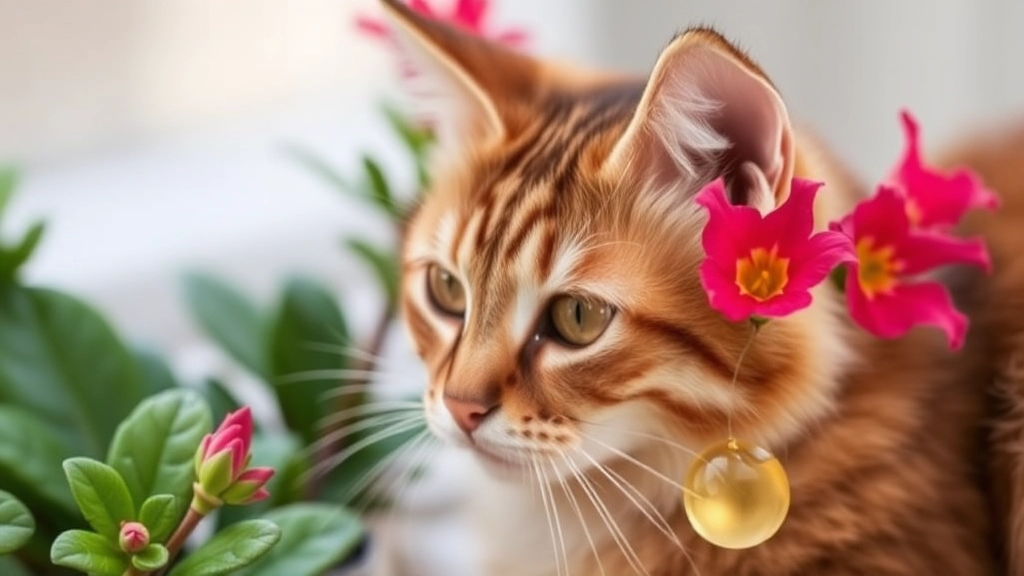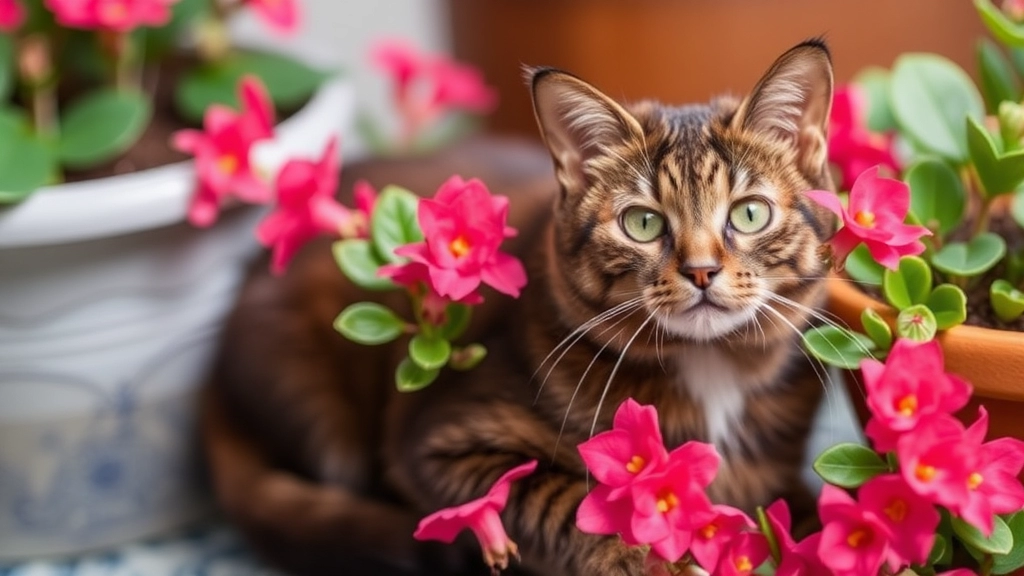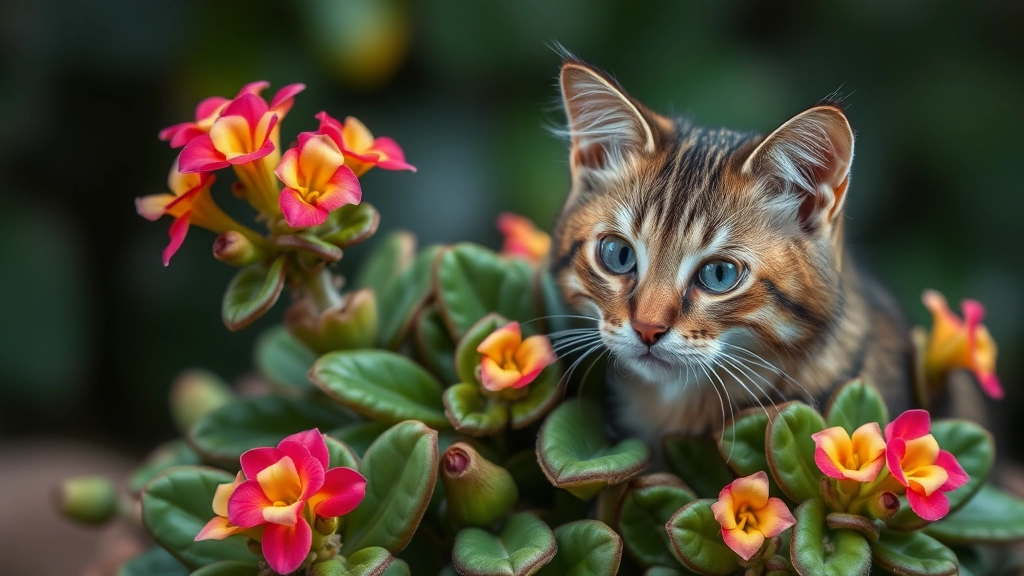Kalanchoe and Cats: A Guide for Pet Owners
As a florist and cat lover, I’ve seen firsthand the dangers that certain plants can pose to our feline friends. In this article, I’ll be shedding light on a common yet potentially hazardous plant: the Kalanchoe. We’ll explore why this popular succulent is toxic to cats, how to identify it, and what steps to take if your furry companion ingests it.
From recognizing the symptoms of Kalanchoe poisoning to understanding the immediate actions needed in case of ingestion, we’ll cover it all. I’ll also share some safe alternatives for cat owners who love greenery in their homes. Remember, knowledge is power when it comes to keeping our pets safe, so let’s dive in and learn how to create a cat-friendly environment without compromising on style.
Identifying Kalanchoe Plants
Alright, let’s dive into identifying Kalanchoe plants. Trust me, it’s not as tricky as it sounds!
What’s the deal with Kalanchoe?
Kalanchoe plants are like the cool kids of the succulent world. They’re everywhere – from your nan’s windowsill to that hipster café down the road. But here’s the kicker: they’re not exactly your cat’s best mate.
So, how do you spot these sneaky succulents? Let’s break it down:
The Leaf Look
- Thick, fleshy leaves (like they’ve been hitting the plant gym)
- Usually oval or paddle-shaped
- Edges might be scalloped or wavy (fancy, right?)
Flower Power
- Clusters of small, star-shaped flowers
- Colours range from red and pink to yellow and white
- Blooms often last for weeks (show-offs!)
Size Matters
- Can be tiny tabletop plants or grow up to 6 feet tall (that’s taller than most of us after a night out!)
Common Types
- Flaming Katy (Kalanchoe blossfeldiana) – The most popular one, with bright flowers
- Panda Plant (Kalanchoe tomentosa) – Fuzzy leaves, looks like it needs a shave
- Mother of Thousands (Kalanchoe daigremontiana) – Produces baby plants on its leaves (talk about overachieving!)
Look, I’m not saying you need to become a plant detective. But knowing what Kalanchoe looks like could save your furry friend from a nasty tummy ache – or worse.
Remember, if you’re ever in doubt, snap a pic and ask your local garden centre. Better safe than sorry, right?
Next time you’re plant shopping, keep an eye out for these Kalanchoe characteristics. Your cat will thank you for it – well, in their own aloof, cat-like way.
Toxic Components of Kalanchoe
Ever wonder what makes Kalanchoe so dangerous for our feline friends?
Let’s break it down, no fancy jargon, just the facts.
Kalanchoe plants pack a punch with their toxic components.
The main culprits? Bufadienolides.
These are cardiac glycosides that mess with the heart’s rhythm.
But that’s not all.
Kalanchoe also contains:
- Daigremontianin
- Bersaldegenin
- Bryophyllin
These compounds are no joke.
They can cause serious harm to cats if ingested.
Here’s the kicker: all parts of the plant are toxic.
Leaves, stems, flowers – the whole shebang.
Even small amounts can lead to trouble.
The concentration of toxins varies depending on:
- Plant species
- Growing conditions
- Time of year
But here’s the thing: we don’t need to panic.
Knowledge is power, right?
By understanding what we’re dealing with, we can keep our kitties safe.
Remember, Kalanchoe toxicity isn’t just a cat problem.
It affects dogs and even humans too.
But cats? They’re especially sensitive.
So, what’s the takeaway?
Kalanchoe’s toxic components are serious business for our feline pals. If you’re considering adding a florist kalanchoe plant to your home, it’s crucial to be aware of its potential dangers. While beautiful, these plants, including the popular Kalanchoe blossfeldiana in various colors, require careful placement to ensure the safety of your pets.
Symptoms of Kalanchoe Poisoning in Cats
Let’s dive into the nitty-gritty of what happens when your feline friend gets a taste of Kalanchoe. Trust me, it’s not pretty, but knowing these signs could save your cat’s life.
The Telltale Signs
First off, if your cat’s been nibbling on Kalanchoe, you might notice:
- Vomiting (and lots of it)
- Diarrhoea (often with blood)
- Drooling like a leaky tap
- Loss of appetite (they’ll turn their nose up at even their favourite treats)
- Weakness (like they’ve just run a kitty marathon)
- Weird heart rhythms (if you can spot ’em)
But wait, there’s more…
The Sneaky Symptoms
Some signs aren’t as obvious, but they’re just as serious:
- Dilated pupils (their eyes might look like black saucers)
- Tremors or seizures (scary stuff, I know)
- Depression (yes, cats can get down in the dumps too)
- Collapse (worst-case scenario)
Time is of the Essence
Here’s the kicker – these symptoms can show up within a few hours of your cat munching on Kalanchoe. And they can last for days. So if you spot any of these, don’t wait around hoping they’ll pass. Get your furry mate to the vet, pronto!
Remember, every cat’s different. Some might show all these symptoms, others just a few. But any of these signs after potential Kalanchoe exposure is a red flag.
Bottom line: Knowing these symptoms of Kalanchoe poisoning in cats could be the difference between a close call and a catastrophe. Keep your eyes peeled, and your cat will thank you (in their own aloof, feline way, of course).
Immediate Steps if Your Cat Ingests Kalanchoe

Oh no! Your cat’s munched on a Kalanchoe. What now?
First things first, don’t panic. We’ve got this.
Here’s your game plan:
- Get that plant away from your kitty, pronto!
- Check their mouth. Any bits left? Gently remove ’em.
- Rinse their mouth with water. It might be a struggle, but it helps.
- Write down when it happened. Vets love details.
- Keep an eye out for weird symptoms. Vomiting? Diarrhoea? Jot it down.
- Ring up your vet. They’re the real MVPs here.
- If your vet says “come in”, don’t dawdle. Get moving!
- Bring the plant with you. It’s like show and tell, but for vets.
Remember, quick action is key when your cat’s been nibbling on Kalanchoe, which can be toxic.
Don’t try to make your cat vomit. Leave that to the pros.
And please, don’t wait it out. Even if your cat seems fine, those Kalanchoe toxins can be sneaky.
Better safe than sorry, right?
Quick tip: Save your vet’s number on speed dial. Trust me, it’s a game-changer.
In the end, knowing what to do if your cat ingests Kalanchoe can make all the difference.
Stay cool, act fast, and let’s keep our furry friends safe! If you’re curious about other Kalanchoe varieties, you might want to check out the Kalanchoe blossfeldiana, a popular indoor plant.
Treatment Options for Kalanchoe Poisoning
Alright, let’s dive into how we can help our feline friends if they’ve had a run-in with Kalanchoe. Trust me, I’ve been there, and it’s not fun for anyone involved.
Quick Action is Key
First things first, if you even suspect your cat’s nibbled on Kalanchoe, don’t wait around. Get them to the vet ASAP. Time’s crucial here, folks.
What to Expect at the Vet’s
So, you’ve rushed your furry pal to the vet. What’s next? Here’s the lowdown:
- Decontamination: They might induce vomiting or use activated charcoal to soak up the toxins.
- IV Fluids: To keep your cat hydrated and flush out the nasties.
- Heart Monitoring: Kalanchoe can mess with the heart, so they’ll keep a close eye on that.
- Medication: Depending on symptoms, they might give meds to control nausea or regulate heart rhythm.
Home Care After Treatment
Once you’re back home, it’s all about TLC:
- Keep ’em Comfy: Set up a quiet, cozy spot for recovery.
- Follow-Up Meds: Stick to the vet’s instructions like glue.
- Watch Like a Hawk: Keep an eye out for any weird symptoms popping up.
Prevention is Better Than Cure
Look, I get it. Kalanchoe’s pretty, but is it worth the risk? Maybe it’s time to rethink your indoor garden game. There are tons of cat-safe plants out there that’ll still make your place look ace.
Remember, quick action and proper treatment can make all the difference when it comes to Kalanchoe poisoning in cats. Stay vigilant, cat lovers!
Preventing Kalanchoe Exposure to Cats

Hey there, cat lovers! Let’s chat about keeping our furry friends safe from kalanchoe plants.
First things first: if you’ve got kalanchoe at home, it’s time to play detective.
Where’s that plant hiding?
Is it within paw’s reach?
Time to get creative with cat-proofing!
Here are some quick tips to keep your kitty safe:
- Elevate your kalanchoe: Put it on a high shelf or hang it up
- Create a barrier: Use a plant terrarium or a cat-proof enclosure
- Redirect attention: Offer safe, cat-friendly plants as alternatives
- Educate your household: Make sure everyone knows the plant is off-limits
But let’s be real â cats are curious creatures.
Sometimes, the best solution is the simplest: consider rehoming your kalanchoe blossfeldiana hybrid.
Your local plant-loving friend might be thrilled to adopt it!
Remember, prevention is key when it comes to kalanchoe and cats.
Stay vigilant, and your feline friend will thank you for it! If you’re looking for a safer alternative, you might want to explore kalanchoe tomentosa varieties, which are generally considered less toxic.
Safe Alternatives to Kalanchoe for Cat Owners
Hey there, fellow cat lovers!
Let’s chat about some awesome plants that won’t send your furry friend to the vet.
Kalanchoe’s off the table, but don’t worry – we’ve got options!
Safe Plants for Your Feline Friends
- Spider Plant
- These are like cat TV – dangling leaves to bat at!
- Bonus: They’re air-purifying superstars.
- Boston Fern
- Lush, green, and totally cat-safe.
- Perfect for that jungle vibe without the danger.
- African Violet
- Pretty flowers that won’t make your kitty poorly.
- Adds a pop of colour to any room.
- Catnip
- Obviously! Your cat’s favourite herb.
- Just be ready for some zoomies!
- Cat Grass
- Gives them something safe to munch on.
- Might save your other houseplants from nibbles.
Why bother with safe plants?
- Peace of mind – no more worrying about emergency vet trips
- Happy cats – they can explore without getting sick
- Pretty home – you still get to enjoy some greenery
Pro tip: Even with safe plants, keep an eye on your cat. Some might get an upset tummy if they eat too much.
Remember, a cat-friendly home is a happy home. Swap out those Kalanchoes and watch your kitty thrive!
Got any favourite cat-safe plants? Drop a comment and let’s share ideas!
Frequently Asked Questions (FAQs)
Q1: How quickly can Kalanchoe poisoning affect my cat?
Symptoms of Kalanchoe poisoning can appear within a few hours of ingestion. The severity and speed of onset can vary depending on the amount consumed and the individual cat’s sensitivity.
Q2: Are all parts of the Kalanchoe plant toxic to cats?
Yes, all parts of the Kalanchoe plant are toxic to cats, including the leaves, stems, flowers, and even the sap. It’s best to keep the entire plant out of reach.
Q3: Can I still keep Kalanchoe plants if I have cats?
While it’s not recommended, if you choose to keep Kalanchoe plants, ensure they are in a completely inaccessible area for your cats. Consider using hanging baskets or closed terrariums.
Q4: What should I do if I suspect my cat has eaten Kalanchoe?
If you suspect your cat has ingested Kalanchoe, contact your veterinarian immediately. Do not wait for symptoms to appear, as early treatment is crucial.
Q5: Are there any long-term effects of Kalanchoe poisoning in cats?
With prompt and proper treatment, most cats recover fully from Kalanchoe poisoning. However, in severe cases, there can be long-term cardiac issues. Follow-up care with your vet is important.
Q6: How can I make my home safer for cats while still enjoying plants?
Opt for cat-safe plants like spider plants, Boston ferns, or African violets. Always research a plant’s toxicity before bringing it into a home with cats.
Q7: Is Kalanchoe poisoning in cats common?
While not the most common plant toxicity in cats, Kalanchoe poisoning does occur. It’s important for cat owners to be aware of the risks, especially as these plants are popular houseplants.

